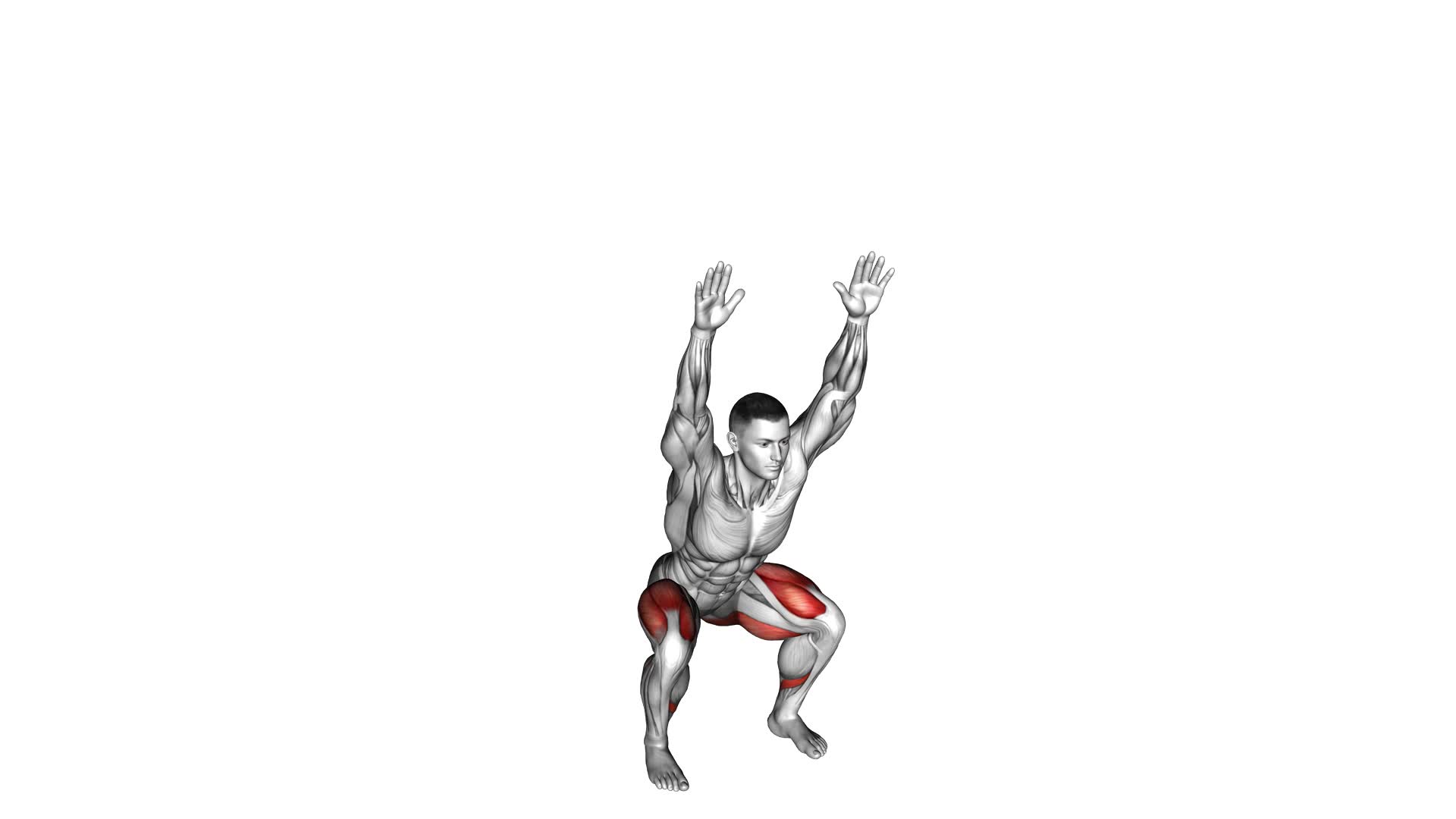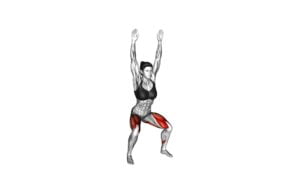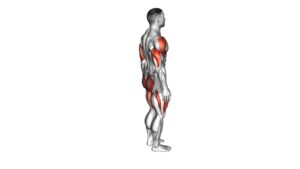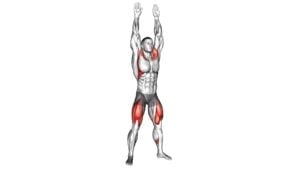Bodyweight Overhead Squat – Video Exercise Guide & Tips

Are you looking for a challenging exercise that targets multiple muscle groups? Look no further than the bodyweight overhead squat!
Watch This Exercise Video
This exercise is perfect for improving strength, stability, and flexibility.
In this video exercise guide, we'll walk you through the proper form and technique, common mistakes to avoid, and modifications to suit your fitness level.
Get ready to maximize your results and take your squat game to the next level!
Key Takeaways
- Targets multiple muscle groups
- Improves strength, stability, and flexibility
- Enhances balance and stability
- Develops core strength
Benefits of Bodyweight Overhead Squat
You can experience numerous benefits from incorporating bodyweight overhead squats into your workout routine. One of the main advantages is improving balance. When you perform overhead squats, you engage multiple muscle groups, including those in your legs, core, and upper body. This exercise requires balance and stability to maintain proper form throughout the movement. By consistently incorporating bodyweight overhead squats into your routine, you can improve your overall balance and stability.
Another benefit of this exercise is developing core strength. The overhead squat specifically targets your core muscles, including your abdominal muscles and lower back. As you squat down and then return to a standing position, your core muscles are engaged to maintain stability and support your spine. Over time, this can lead to a stronger and more stable core, which is essential for many other exercises and daily activities.
Incorporating bodyweight overhead squats into your workout routine is an effective way to improve balance and develop core strength. By focusing on these two areas, you can enhance your overall fitness and performance in other activities. So, don't hesitate to add bodyweight overhead squats to your exercise routine and start reaping the benefits today.
Proper Form and Technique
To perform the bodyweight overhead squat with proper form and technique, start by positioning yourself with your feet shoulder-width apart. As you begin the movement, extend your arms fully overhead, ensuring that your wrists are in line with your shoulders. Throughout the squat, maintain a neutral spine, engage your core, and keep your chest lifted.
To improve mobility for the overhead squat, it's important to work on your flexibility and range of motion. Incorporating exercises such as shoulder dislocations, thoracic spine rotations, and hip openers can help you achieve better mobility in the necessary joints.
There are several variations of the bodyweight overhead squat that you can incorporate into your routine to add variety and challenge. Some examples include the single-leg overhead squat, where you perform the squat on one leg while keeping the other leg extended in front of you, and the pistol squat with overhead reach, where you perform a pistol squat while extending your arms overhead.
By mastering the proper form and technique of the bodyweight overhead squat and incorporating variations to challenge yourself, you can improve your strength, stability, and mobility. This will set a solid foundation for progressing to more advanced exercises.
Now let's move on to the next section, where we'll discuss common mistakes to avoid in order to perform the bodyweight overhead squat safely and effectively.
Common Mistakes to Avoid
Avoiding common mistakes is crucial when performing the bodyweight overhead squat. To ensure proper form and technique, it's important to be aware of the common mistakes that people often make during this exercise.
One common mistake is allowing the knees to cave inwards during the squat. To avoid this, focus on pushing your knees outwards and maintaining a wide stance throughout the movement.
Another mistake is rounding the lower back, which can put unnecessary strain on the spine. To prevent this, engage your core muscles and maintain a neutral spine position throughout the exercise.
Additionally, be mindful of your shoulder and wrist positioning. Many people tend to internally rotate their shoulders and allow their wrists to collapse, which can lead to discomfort and injury. To maintain proper form, actively push the weight overhead, keep your shoulders externally rotated, and ensure that your wrists are straight and stacked above your elbows.
Modifications and Progressions
To modify or progress the bodyweight overhead squat, you can incorporate variations using different equipment or increase the difficulty level by adding weights. These modifications and progressions not only help prevent injuries but also challenge your muscles in new ways, leading to greater strength gains and improved overall fitness.
One option for modifying the bodyweight overhead squat is to use a resistance band. This can provide assistance as you work on improving your squat technique or help you maintain proper form if you have limited mobility.
Another option is to perform the squat using a stability ball against a wall. This adds an element of balance and stability to the exercise, engaging more muscles in your core and lower body.
If you're looking to progress the bodyweight overhead squat, you can start by using a barbell instead of just your bodyweight. Adding weight to the movement increases the resistance and challenges your muscles even more.
You can also try performing the squat on an unstable surface, such as a BOSU ball, to further engage your core and improve your balance.
By incorporating these modifications and progressions into your bodyweight overhead squat routine, you can continuously challenge your muscles and avoid plateaus in your training. This will help you maximize your results and achieve your fitness goals more effectively.
Now, let's move on to the next section, where we'll discuss some tips for maximizing your results with the bodyweight overhead squat.
Tips for Maximizing Results
To maximize your results with the bodyweight overhead squat, focus on proper form and gradually increase the difficulty level of the exercise. This will ensure that you're targeting the right muscles and challenging yourself enough to see progress.
In addition to these key points, there are a few other tips that can help you maximize your results.
Firstly, pay attention to your nutrition and recovery strategies. Eating a balanced diet that includes sufficient protein, carbohydrates, and healthy fats will provide your body with the necessary fuel to perform the exercise and aid in muscle recovery. Additionally, make sure to prioritize sleep and rest days to allow your muscles to repair and grow stronger.
Consistency and dedication are also crucial for maximizing results. It's important to perform the bodyweight overhead squat regularly and consistently to see progress. Set specific goals for yourself and track your progress over time to stay motivated and on track. Push yourself to do a little more each time, whether it's increasing the number of repetitions or adding weight.
Frequently Asked Questions
How Many Calories Does a Bodyweight Overhead Squat Burn?
The bodyweight overhead squat is a challenging exercise that can help you burn calories and improve flexibility. While the exact number of calories burned depends on factors like your weight and intensity, this exercise can be an effective calorie-burning workout.
Additionally, the overhead squat engages multiple muscle groups, promoting strength and stability. As you perform this exercise regularly, you may also notice improvements in your flexibility, as it requires a good range of motion in your hips, knees, and shoulders.
Can the Bodyweight Overhead Squat Help Improve Flexibility?
The bodyweight overhead squat is a great exercise for improving flexibility and mobility. By performing this exercise, you're able to work multiple muscle groups and increase your range of motion.
Bodyweight exercises like the overhead squat have numerous benefits, including improving strength, stability, and overall body control.
Incorporating bodyweight exercises into your fitness routine can help you achieve your fitness goals while also enhancing your flexibility and mobility.
What Muscles Does the Bodyweight Overhead Squat Target?
The bodyweight overhead squat targets multiple muscles in your body. It helps in improving balance by engaging your core muscles, lower back, and hips.
This exercise also develops your core strength by working your abdominal muscles and obliques. Additionally, it engages your quadriceps, hamstrings, and glutes in the lower body.
Is the Bodyweight Overhead Squat Suitable for Beginners?
The bodyweight overhead squat can be challenging for beginners. It requires good flexibility, stability, and core strength.
However, with proper modifications and technique, you can gradually build up to it. Start by practicing the squat without weights to work on your form. Focus on maintaining a neutral spine and keeping your knees aligned with your toes.
Common mistakes in the bodyweight overhead squat include rounding the back and letting the knees cave in. Practice with caution and seek guidance if needed.
Are There Any Specific Warm-Up Exercises Recommended Before Performing the Bodyweight Overhead Squat?
Before attempting the bodyweight overhead squat, it's important to warm up properly to prevent injury and improve performance.
Incorporate dynamic stretches, like arm circles and leg swings, to increase your range of motion.
To enhance mobility, try exercises such as shoulder dislocations and ankle rotations.
These warm-up activities will prepare your body for the demands of the bodyweight overhead squat and help you achieve better results.
Conclusion
In conclusion, the bodyweight overhead squat is a highly effective exercise for strengthening the lower body and improving overall stability and flexibility.
By maintaining proper form and technique, avoiding common mistakes, and utilizing modifications and progressions, you can maximize your results and achieve your fitness goals.
Remember to always prioritize safety and consult with a professional trainer if needed.
Keep pushing yourself and enjoy the benefits of this challenging yet rewarding exercise.

Author
Years ago, the spark of my life’s passion ignited in my mind the moment I stepped into the local gym for the first time. The inaugural bead of perspiration, the initial endeavor, the very first surge of endorphins, and a sense of pride that washed over me post-workout marked the beginning of my deep-seated interest in strength sports, fitness, and sports nutrition. This very curiosity blossomed rapidly into a profound fascination, propelling me to earn a Master’s degree in Physical Education from the Academy of Physical Education in Krakow, followed by a Sports Manager diploma from the Jagiellonian University. My journey of growth led me to gain more specialized qualifications, such as being a certified personal trainer with a focus on sports dietetics, a lifeguard, and an instructor for wellness and corrective gymnastics. Theoretical knowledge paired seamlessly with practical experience, reinforcing my belief that the transformation of individuals under my guidance was also a reflection of my personal growth. This belief holds true even today. Each day, I strive to push the boundaries and explore new realms. These realms gently elevate me to greater heights. The unique combination of passion for my field and the continuous quest for growth fuels my drive to break new ground.







